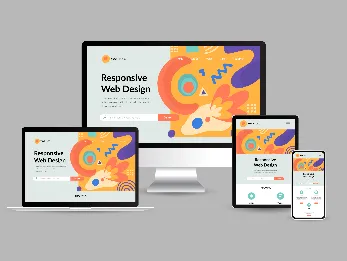Avoid these website design mistakes at all costs
6 mins | 04 Apr 2023

Table Of Contents
2. What is Web Design, And Why is it Important?
3. What Are The Common Mistakes Made During Designing A Website?
c) Lack Of Mobile Optimization
Introduction
Imagine you have a great idea for a website, spend countless hours designing and coding it, and finally launch it. But you're met with bugs instead of the expected influx of visitors and positive feedback.
What went wrong? Well, as it turns out, people make plenty of common mistakes in website design that can prevent their websites from being successful.
In this blog, we'll be taking a closer look at some of these mistakes and how to avoid them, so you can create a website that not only looks great but also performs well and meets the needs of your audience.
What is Web Design, And Why is it Important?
Web design refers to creating and designing a website's look, feel, and functionality. It involves a range of elements, including layout, color, typography, imagery, user interface (UI), and user experience (UX) design, to create a website that is visually appealing, user-friendly, and effective in achieving its goals.
Web design is crucial for several reasons. Firstly, it can significantly impact a website's user experience (UX). A well-designed website can create a positive first impression, engage users, and help them find the information they need quickly and easily. Conversely, a poorly designed website can frustrate users, lead to high bounce rates, and harm the reputation of the business or organization.
Secondly, web design is essential for branding and marketing. A website is often the first point of contact between a business and its customers, and the website must reflect the brand identity and values. A well-designed website can help build brand recognition and loyalty, increase customer trust, and drive conversions.
Lastly, web design is crucial for search engine optimization (SEO). A well-designed website optimized for speed and mobile-friendly can help improve its search engine rankings, resulting in more organic traffic and higher visibility.
In short, web design is essential because it can impact a website's user experience, branding and marketing, and search engine optimization (SEO). A well-designed website can help a business or organization achieve its goals, whether to generate leads, increase sales, or provide information to its customers.
What Are The Common Mistakes Made During Designing A Website?
Designing a website is a complex process that requires careful consideration and planning to ensure a successful outcome. Unfortunately, even the most well-intentioned designers can make mistakes that can significantly impact user experience. Many common mistakes can compromise a website's effectiveness, from poor navigation to slow load times.
In this context, it is essential to identify these common mistakes and take proactive steps to avoid them. This article will explore some of the most common mistakes made while designing a website and provide tips on avoiding them. By following these guidelines, designers can create optimized websites for user experience, engagement, and conversion.
Many common mistakes can be made while designing a website. Here are some of the most common ones:
1. Poor Navigation:
Navigation is one of the most important aspects of a website. And the first web design mistake incurred by many businesses is having difficult navigation on their website. If users can't find what they are looking for easily, they will quickly become frustrated. If the information cannot be accessed quickly and smoothly, then the users would prefer to leave!
Therefore, you need to ensure that your navigation is clear and easy to use. Better & swift navigation helps your website to appear in a more organized way, and retains potential leads for a longer time on your website.
Solution:
- Outline The Navigation Pathways — Create a structure for how users will move around your website. You need to ensure that essential pages are easily reachable through your navigation menu.
- Easier Navigation To Home Page — It must be easy for your web visitors to navigate back to the homepage of your website, whether it is via the company logo or navigation menu. Remember to add these features that make browsing an easy process.
- Review The Links — Cross check your links on the website to ensure that they function and direct to their exact destinations. Visitors or users tend to lose interest in engaging when they click on the broken links.
2. Slow Load Time:
Having a website that loads too slow is another great example of poorly designed websites. Users have a short attention span, and if your website takes too long to load, they will quickly move on to another site. In today’s world, people expect to receive quick answers or solutions, and if your website takes an eternity to load, they are definitely going to leave! Ensure that your website is optimized for fast load times.
Solution:
- Utilize Page Speed Tool & Services — Begin with evaluating your page loading speed by using various tools such as Google PageSpeed. These types of tools will give you recommendations on how to optimize your web page. You can also consider investing in page speed optimization services in order to improve your website speed.
- Optimize Elements — One of the primary reasons for slow loading websites is none other than large sizes of files such as images, videos, GIFs, etc. But, to speed up the speed of your website, optimizing these elements i.e., compressing & resizing them using compression tools can help a lot in accelerating the website speed.
3. Absence Of Responsive Web Design:
With the rise of mobile devices, it's important for your website to be mobile optimized. It is a significant part of delivering a smooth used experience. If your website lacks responsive web design, then your brand won't be able to provide a seamless experience to users utilizing mobile devices such as smartphones, tablets, etc. They might have to browse the desktop version of the website on their mobile devices, which can make it difficult to read the information & navigate your website. Ensure that your website is responsive and looks good on all devices.
Solution:
- Utilize Responsive Tools — The mobile-friendly test of Google will assist you to find out if your website is mobile-friendly or not! You may utilize this at the beginning to determine if your website is mobile-friendly already.
- Implement Responsive Design — If you utilize a WordPress website, you have the option to select a responsive theme. Other than that, you can even check out this article “Basics Of Responsive Design” or get in touch with 12Grids (We Will Be Happy To Help!).
4. Too Much Clutter:
If your website is cluttered with too much information, it can overwhelm users. Many websites make the mistake of overcrowding their website with abundance of information, graphics, etc. But you need to remember that too many elements on your website will drive off visitors even before they could learn about your brand. Ensure that your website has a clean and simple design. Therefore, it's time to declutter your website!
Solution:
- Remove Unnecessary Elements — The best way to make your website impressive is to have a minimalistic approach. Invest some time to declutter your website and just retain the necessary elements so that your visitors are likely to stay longer.
- Build An Organized Website — Reorganizing your website is not a bad idea, instead it's the best thing to enhance the positioning of your brand online! Remember that no one likes to navigate through a disorganized website.
- Use More Of White Space — You must be wondering about what to do with white space? Well, it helps in making your website appear neat & it's pretty easy for people to browse the website. White space helps the audience to grasp the information quickly and also prevents you from using too many elements.
5. Poor Or Outdated Content:
Content is king; if your website has poor or outdated content, users will quickly lose interest! It would make your website less trustworthy and come across as lazy or irresponsible as you don't even care to deliver the right information at the right time! Visitors would bounce back and move to other websites that provide up-to-date information. You must make sure that your content is high-quality, informative, and engaging. Add well-researched blogs, news, and comprehensive guides to the website.
Solution:
- Update Your Content — It's okay to take some out to do your research on latest industry trends and you might even review your competitors for the same. Once done, update the content on the website to stay ahead of the curve.
- Utilize Evergreen Content — Yes, there's something called evergreen content, which means the content that doesn't change drastically with time and continues to stay relevant to your industry and target audience.
6. Lack of Call To Action:
If your website doesn't have clear call-to-action buttons, users may not know what to do next! Whether you want your audience to follow your social media accounts, sign up for your newsletter, get in touch with your brand and more, you need to have captivating CTAs. Ensure that your website has clear and prominent call-to-action buttons.
There are a lot of common mistakes that websites make with CTAs such as not making them enticing, not utilizing them on their websites or home pages, not using a particular colour to highlight the CTAs buttons, etc. Visitors need to clearly understand the purpose of your business and they must have the simplest means possible to understand how to use or identify the CTAs buttons.
Solution:
- Make Your CTAs Enticing — CTAs that are able to dangle a carrot in front of your target audience, are actually actionable! CTAs are the ones that indicate what exactly they need to do next!
- CTAs Must Be Able To Grab The Attention Of Your Audience — Your calls-to-action should catch people's attention! This involves making them distinct from the rest of your content. Just like your navigation menu items, ensure your CTAs stand out on the page with vibrant colors and interactive hover effects.
7. Poor Color Choices:
Honestly, the worst mistake that can ever be committed by a brand is to choose the poor colour palette for their website. The colors you choose for your website can greatly impact user experience because colours are the first & foremost thing that anyone notices! Do not use too many colours as your website should not overwhelm the visitors. Plus, it makes your website more confusing. Ensure that your color choices are appropriate for your brand and easy for the eyes.
Solution:
- Choose A Limited Colour Palette — You must know that an ideal colour palette for designing websites only consists of 3 to 4 colours! The allocation for those colors should consist of a primary color, along with one to two additional accent colors, and your chosen text color.
- Select Colours That Mirror Your Brand Identity — The colours that you select must be able to create brand recognition. Individuals are going to associate your website colour with your brand.
- Learn About Colour Psychology — Before selecting colours for your website, you must understand the concept of colour psychology. People feel certain emotions while looking at different colours, that's why it is essential to learn how colours have a great influence over your target audience.
Final Thoughts
It's true that having a poorly designed website can drive away potential customers or users in seconds! Therefore, a website makeover becomes necessary to drive success and create a unique online presence for your website. We have lots of great website designs that we have delivered successfully and they prove how we've helped our clients make new websites they really like!
In conclusion, a website will be great if we avoid as many mistakes as possible. The 12Grids team is an expert in that domain!
Want to get a UX-driven and SEO-friendly website done? Get in touch with 12Grids now and talk to one of our web design specialists about how we can help you to renovate your website!
Author

Share
Share
Related

Polymers, Innovation, And A Modern Website: The Goldstab Organics Journey
5 mins : 10 Nov 2025

From Friction to Finish Line: The God of Sports Digital Transformation
6 mins : 17 Sept 2025

The Future Of Responsive Web Design: Emerging Trends, Innovations And Predictions In 2024
7 mins : 26 Apr 2024
Other Articles

Responsive Web Design: Understanding The Basics For Seamless User Experiences
7 mins : 29 Apr 2024

Everything You Should Know About The Ideal Screen Size For Responsive Design
6 mins : 26 Apr 2024

Enhance Your Web Design Creativity with Google Web Designer
4 mins : 17 Nov 2023
